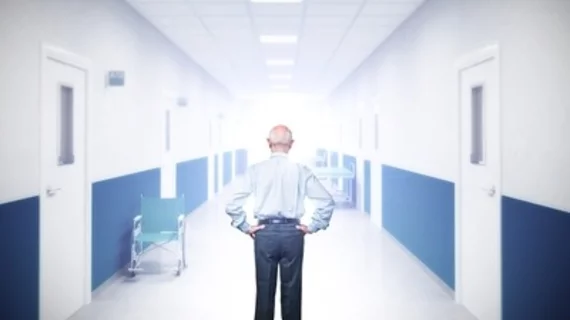Differences in hospitals' short-term heart failure mortality persist to 5 years
Heart failure patients treated at hospitals with lower 30-day mortality rates also enjoy a survival benefit one, three and even five years later, suggesting a short-term risk-standardized mortality rate (RSMR) may deserve additional weight in CMS’s financial incentive programs.
Corresponding author Gregg C. Fonarow, MD, and colleagues published these findings in the June issue of JAMA Cardiology.
A decade ago, CMS mandated public reporting of 30-day risk-standardized readmission rates (RSRRs) and 30-day RSMRs for common conditions including heart failure. Since then, the agency has imposed financial penalties on hospitals performing below certain benchmarks in those areas. However, the current incentive program is heavily skewed toward the readmissions metric, penalizing hospitals up to 3 percent in 2016 for excessive readmissions versus only 0.2 percent for excessive 30-day mortality.
Some research suggested that the Hospital Readmissions Reduction Program has incentivized providers to reduce 30-day readmissions at the cost of longer-term outcomes, which “may have inadvertently encouraged inappropriate care practices,” Fonarow and colleagues wrote.
In this study, the authors showed for the first time that adjusted 30-day mortality rates persist in the long run. Compared to patients treated by hospitals in the quadrant with the lowest 30-day RSMRs, those in the highest quadrant were 14 percent less likely to survive five years. The same 14 percent difference was present at three years.
“The survival advantage associated with treatment at hospitals with lower 30-day RSMR was durable over time independent of mortality differences within the first 30 days,” Fonarow et al. noted. “Lower 30-day RSMR was associated with better adherence of key process of care measures, greater availability of advanced HF therapies, and better 1-year, 3-year, and 5-year survival. Taken together, these findings highlight the need to increase the focus on 30-day RSMR as a performance metric to incentivize quality care and to improve long-term clinical outcomes for patients with HF.”
Some of those better care processes included implanting cardioverter defibrillators, prescribing cardiac resynchronization therapy and scheduling follow-up appointments. The authors found there were no “clinically meaningful” differences in demographic characteristics of the patients admitted to hospitals in different quadrants, other than a higher socioeconomic status for patients in the lowest-mortality centers.
The 30-day RSMR ranged from 8.6 percent in the first quadrant to 10.7 percent in the fourth quadrant, and the corresponding five-year mortality rates were 73.7 percent and 76.8 percent, respectively. Hospitals with lower death rates were more likely to be larger, urban centers with greater availability of percutaneous coronary intervention, cardiac surgery and advanced heart failure therapies.
The analysis included 106,304 Medicare patients hospitalized at 317 centers participating in the Get With the Guidelines-Heart Failure registry. Patients were 81 years old on average, 54.1 percent women and 79.6 percent white.
Fonarow and colleagues said the observational nature of their study doesn’t allow causation to be established for the correlation between 30-day and long-term survival.

